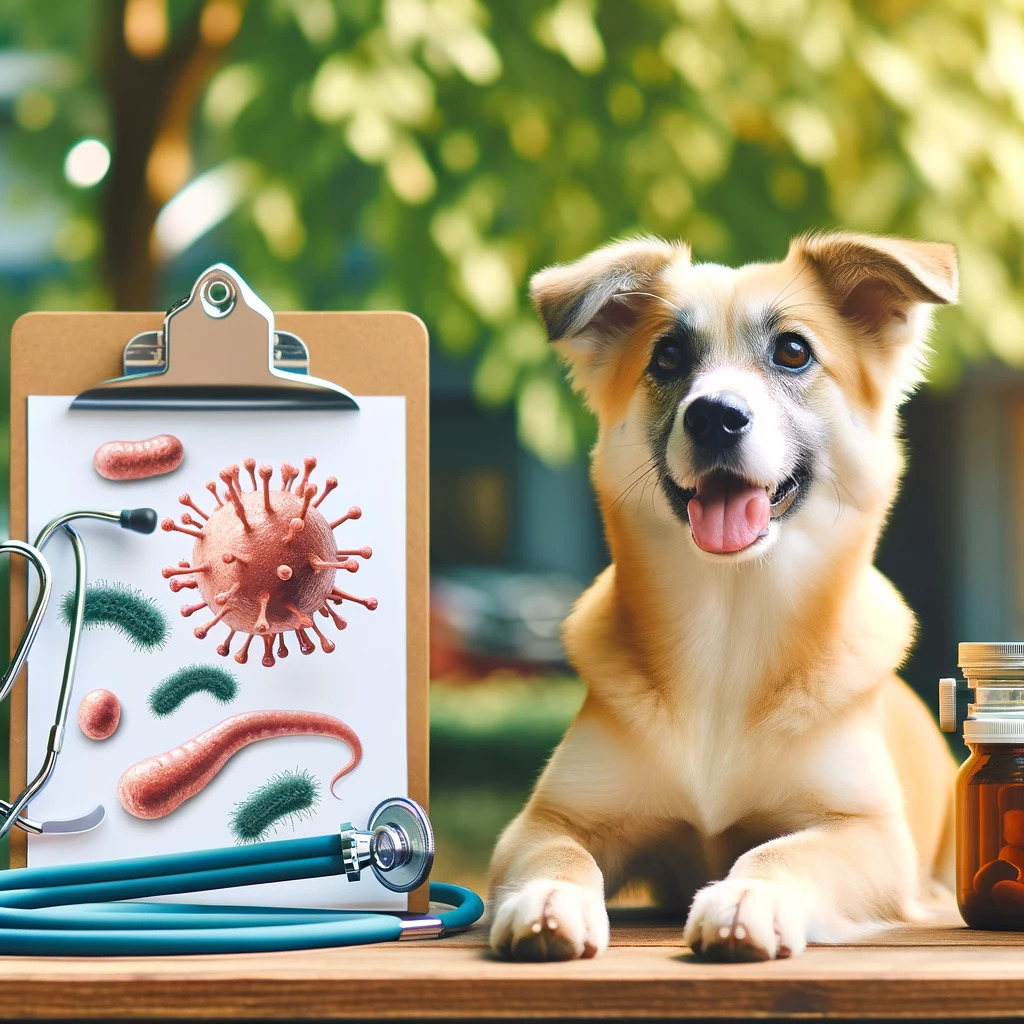Coccidioidomycosis, commonly known as “Valley Fever,” is a significant health concern for dog owners, especially in certain geographic areas. This article aims to address the most pressing questions about this disease, providing dog owners with the knowledge they need to recognize, prevent, and manage this condition in their furry friends.
What is Coccidioidomycosis and How Does it Affect Dogs?
Coccidioidomycosis is a fungal infection caused by the Coccidioides species, which is commonly found in soil in specific regions, notably the Southwestern United States. When dogs inhale the fungal spores, they can develop a variety of symptoms, ranging from respiratory issues to more severe systemic illness.
- Geographical Prevalence: The fungus thrives in arid climates, such as those found in Arizona, California, New Mexico, and Texas. It’s crucial for dog owners in these areas to be aware of the risks.
- Symptoms and Signs: Dogs with coccidioidomycosis may exhibit coughing, fever, weight loss, lack of energy, and more. Some may develop more severe symptoms like lameness or swelling of limbs due to joint involvement.
- Transmission and Exposure: Dogs get infected by inhaling spores from the soil. The risk is higher in dogs that spend a lot of time outdoors, particularly in areas where the soil is disturbed.
- Diagnosis: Diagnosis typically involves chest X-rays, blood tests, and sometimes tissue biopsies. It’s essential to diagnose early for effective treatment.
- Treatment Options: Antifungal medications are the mainstay of treatment. The duration and type of treatment depend on the severity of the disease.
- Preventive Measures: Limiting exposure to high-risk areas can reduce the chance of infection. There is no vaccine available, so avoidance and awareness are key.
- Impact on Different Dog Breeds: Some breeds may be more susceptible than others, but all dogs that are exposed to the spores can potentially contract the disease.
- Long-Term Management: Chronic cases may require lifelong treatment. Regular veterinary check-ups are important for managing the disease effectively.
- Potential Complications: Without treatment, the infection can spread to bones, skin, and other organs, leading to serious health issues.
- Supporting Your Dog’s Health: Alongside medical treatment, proper nutrition, hydration, and a stress-free environment contribute to your dog’s recovery.
How is Coccidioidomycosis Diagnosed in Dogs?
Diagnosing coccidioidomycosis in dogs is crucial for effective treatment and management. This section outlines the steps and methods used in diagnosing this fungal infection.
- Recognizing Symptoms: The first step is observing symptoms like coughing, fever, and lethargy. Dog owners should monitor their pets closely, especially if they live in or have traveled to endemic areas.
- Veterinary Examination: A thorough physical examination by a veterinarian is essential. The vet may look for swollen lymph nodes, respiratory distress, or lameness.
- Blood Tests: Blood tests, including a complete blood count (CBC) and biochemistry profile, can indicate infection. Specific antibody tests can also be done to detect exposure to the fungus.
- Imaging Techniques: Chest X-rays or ultrasounds may be used to check for lung involvement or other internal changes.
- Tissue Biopsy: In some cases, a biopsy of affected tissues may be necessary to confirm the diagnosis.
- Fungal Culture: Culturing the fungus from sputum or tissue samples provides definitive evidence of the infection.
- Serology Tests: These tests look for antibodies against Coccidioides in the dog’s blood, indicating exposure to the fungus.
- Differential Diagnosis: It’s important to rule out other diseases with similar symptoms, such as bacterial pneumonia or cancer.
- Regular Monitoring: Follow-up tests may be needed to monitor the dog’s response to treatment.
- Consulting a Specialist: In complicated cases, a veterinary infectious disease specialist or internal medicine specialist might be consulted for more advanced diagnostic techniques.
What Are the Treatment Options for Coccidioidomycosis in Dogs?
Treating coccidioidomycosis effectively is vital for the health and well-being of affected dogs. This section discusses the various treatment approaches and considerations for managing this disease.
- Antifungal Medications: The cornerstone of treatment is antifungal therapy. Commonly used medications include fluconazole, itraconazole, and ketoconazole. The choice of drug depends on the severity and location of the infection.
- Duration of Treatment: Treatment duration can vary significantly, often lasting several months to over a year. It’s important to continue treatment as prescribed by the veterinarian, even if symptoms improve.
- Monitoring Treatment Response: Regular follow-up with the vet is necessary to assess the dog’s response to treatment and make any necessary adjustments.
- Managing Side Effects: Antifungal medications can have side effects, such as liver toxicity or gastrointestinal upset. Regular blood tests may be required to monitor for these effects.
- Supportive Care: Supportive care, including good nutrition and hydration, is essential. Pain management and other supportive treatments may be necessary for dogs with severe symptoms.
- Lifestyle Adjustments: Limiting a dog’s exposure to dusty or sandy environments can help reduce the risk of reinfection.
- Surgery in Severe Cases: In some severe cases, particularly where there are bone lesions or lung nodules, surgical intervention might be necessary.
- Alternative Therapies: Some vets might consider alternative therapies or supplements to support the dog’s immune system, although these should never replace conventional treatment.
- Cost of Treatment: Owners should be prepared for the potential cost of long-term antifungal treatment, which can be significant.
- Prognosis: With timely and appropriate treatment, many dogs recover well, though some may require long-term management of the disease.
What Are the Common Symptoms of Coccidioidomycosis in Dogs?
Identifying the symptoms of coccidioidomycosis is crucial for early diagnosis and treatment. This section outlines the common signs that dog owners should be aware of.
- Respiratory Issues: One of the first signs can be respiratory problems like coughing or difficulty breathing, especially if the fungus has affected the lungs.
- Fever and Lethargy: Dogs might exhibit fever and a general sense of lethargy or reduced energy levels.
- Weight Loss and Appetite Changes: Affected dogs may experience a loss of appetite leading to noticeable weight loss.
- Swollen Lymph Nodes: The lymph nodes, particularly those near the site of infection, may become swollen.
- Lameness or Swelling: If the infection spreads to bones or joints, it can cause lameness or swelling in the limbs.
- Skin Lesions: In some cases, dogs might develop skin ulcers or lesions, especially if the infection has become disseminated.
- Eye Problems: Ocular issues, including inflammation, can occur if the infection involves the eyes.
- Behavioral Changes: Dogs might show changes in behavior due to discomfort or pain.
- Neurological Symptoms: In rare cases, if the central nervous system is affected, symptoms could include seizures or changes in coordination.
- Variation in Symptoms: It’s important to note that symptoms can vary widely from dog to dog, and some may show only mild signs or even be asymptomatic.
Can Coccidioidomycosis in Dogs Be Prevented?
While it’s challenging to completely prevent coccidioidomycosis, there are steps dog owners can take to reduce their pets’ risk. This section discusses preventive measures.
- Avoidance of High-Risk Areas: If you live in or visit an endemic area, try to limit your dog’s exposure to dusty environments, construction sites, and other areas where the soil is likely to be disturbed.
- Close Supervision: Keep a close watch on your dog during outdoor activities, ensuring they don’t dig or sniff in soil that might be contaminated.
- Indoor Sheltering: During windy days or when there’s a disturbance in the soil nearby, it’s safer to keep your dog indoors as much as possible.
- Regular Health Check-ups: Regular vet visits for health assessments can help in early detection and treatment, should your dog contract the disease.
- Education and Awareness: Educating yourself about the symptoms and risks of coccidioidomycosis can help in quick identification and prompt treatment.
- Healthy Lifestyle: Maintaining your dog’s overall health through proper nutrition and exercise can strengthen their immune system.
- Immediate Veterinary Care: If you suspect your dog has been exposed to the fungus, consult a veterinarian immediately.
- Clean Living Environment: Keeping your dog’s living area clean and free from dust can help reduce the risk.
- Protective Measures: For dogs that are frequently exposed to high-risk areas, discuss with your veterinarian about any possible protective measures.
- Community Awareness: Spreading awareness in your community about the risks and prevention of coccidioidomycosis can help protect all dogs in the area.
Are Certain Dog Breeds More Susceptible to Coccidioidomycosis?
Understanding if some dog breeds are more prone to coccidioidomycosis can help in taking preventive measures and early detection. This section explores breed-specific susceptibilities to the disease.
- Breed Susceptibility Research: Studies suggest that certain breeds, such as Pointers, Doberman Pinschers, and German Shepherds, might have a higher incidence of coccidioidomycosis.
- Genetic Factors: The reasons for breed susceptibility could be linked to genetic factors that affect the immune response to the fungus.
- Environmental Exposure: Regardless of breed, environmental exposure is a significant risk factor. Dogs that spend more time outdoors in endemic areas are at higher risk.
- Age and Health Considerations: Younger and older dogs, as well as those with compromised immune systems, regardless of breed, may be more susceptible.
- Monitoring High-Risk Breeds: If you own a breed that may be at higher risk, it’s important to be vigilant about symptoms and seek veterinary care promptly if you suspect infection.
- Preventive Measures for All Breeds: All dog owners, irrespective of their pet’s breed, should follow preventive measures to reduce the risk of coccidioidomycosis.
- Regular Veterinary Check-Ups: Regular health checks are crucial for early detection, especially in breeds at higher risk.
- Lifestyle Adjustments: For high-risk breeds, minimizing activities in areas where the fungus is prevalent can be a helpful precaution.
- Educating Yourself About the Disease: Understanding the symptoms and risks associated with coccidioidomycosis is vital for all dog owners, regardless of breed.
- Community Support and Awareness: Sharing information within your community, especially with owners of susceptible breeds, can help in managing the overall risk.
How Does Coccidioidomycosis Progress in Dogs?
Understanding the progression of coccidioidomycosis is crucial for dog owners to manage their pet’s health effectively. This section outlines the typical course of the disease.
- Initial Infection: The infection starts when a dog inhales fungal spores. Initially, symptoms might be mild or non-existent.
- Incubation Period: There is an incubation period, the length of which can vary, during which the dog might not show any signs of illness.
- Early Symptoms: Early signs are often respiratory, such as coughing or wheezing, and can be easily confused with other respiratory diseases.
- Systemic Spread: In some cases, the fungus can spread from the lungs to other parts of the body, including bones, eyes, and lymph nodes, leading to more severe symptoms.
- Acute Versus Chronic: The disease can take an acute (sudden and severe) or chronic (long-lasting) form. Chronic cases may show intermittent symptoms.
- Severity of Symptoms: Severity can range from mild to life-threatening, depending on the dog’s immune response and the extent of the infection.
- Potential Complications: Without appropriate treatment, complications such as severe lung disease, bone infections, and dissemination to other organs can occur.
- Response to Treatment: With treatment, many dogs show improvement within a few weeks, but some may require prolonged therapy.
- Monitoring and Follow-Up: Regular veterinary follow-ups are essential to monitor the progression of the disease and adjust treatment as needed.
- Prognosis: The prognosis varies; while many dogs respond well to treatment, those with disseminated disease may face a more challenging recovery.
What is the Impact of Coccidioidomycosis on a Dog’s Long-Term Health?
The long-term health implications of coccidioidomycosis can vary. This section delves into what dog owners can expect in the aftermath of this fungal infection.
- Chronic Health Issues: Some dogs may experience chronic health problems post-infection, especially if the disease was severe or widespread.
- Ongoing Medication: Dogs that have recovered from coccidioidomycosis may require ongoing antifungal medication, sometimes for life, to prevent recurrence.
- Regular Veterinary Monitoring: Continuous monitoring, including regular blood tests and check-ups, is important to manage any long-term effects.
- Potential for Relapse: There is a risk of relapse, particularly in dogs that have had a severe or disseminated infection.
- Impact on Quality of Life: While many dogs return to normal life post-treatment, some may have lingering issues such as joint pain or reduced stamina.
- Nutritional Support: A balanced diet, possibly with supplements to boost the immune system, can be beneficial in supporting long-term health.
- Exercise and Activity Levels: Dogs may need a modified exercise regimen post-recovery, especially if they have joint or bone involvement.
- Mental Health Considerations: Chronic illness can affect a dog’s mood and behavior, so mental health and comfort are important aspects of long-term care.
- Financial Impact: Owners should be prepared for the potential financial impact of long-term treatment and care.
- Support and Resources: Seeking support from veterinarians, support groups, and online resources can be helpful in managing your dog’s long-term health post-coccidioidomycosis.
Can Coccidioidomycosis Recur in Dogs After Treatment?
Recurrent coccidioidomycosis is a concern for many dog owners. This section explores the likelihood and management of recurrence after treatment.
- Risk of Recurrence: Dogs that have recovered from coccidioidomycosis can experience a recurrence, especially if they have a weakened immune system or if the initial infection was severe.
- Importance of Completing Treatment: Completing the full course of prescribed antifungal medication is crucial in reducing the risk of recurrence.
- Monitoring After Recovery: Regular veterinary check-ups post-recovery are essential to detect any signs of recurrence early.
- Long-term Medication: Some dogs may require long-term or even lifelong medication to prevent recurrence, depending on the severity of their initial infection.
- Environmental Control: Minimizing exposure to areas where Coccidioides spores are prevalent remains important even after recovery.
- Immune System Support: Maintaining a healthy lifestyle and diet to support the immune system can help reduce the risk of recurrence.
- Prompt Response to Symptoms: If symptoms reappear, immediate veterinary consultation is essential for quick intervention.
- Education and Awareness: Continual education about the disease and its symptoms helps in early detection and treatment of recurrent cases.
- Community and Support Groups: Engaging with community groups and forums can provide support and updated information about managing recurrence.
- Research and Emerging Treatments: Staying informed about new research and treatments can provide additional options for managing and preventing recurrence.
What Are the Potential Complications of Coccidioidomycosis in Dogs?
Recognizing potential complications of coccidioidomycosis is important for managing the health of affected dogs. This section details the complications that may arise from this fungal infection.
- Disseminated Disease: One of the most serious complications is the spread of the fungus beyond the lungs to other parts of the body, such as bones, eyes, and even the brain.
- Respiratory Distress: Severe lung infections can lead to respiratory distress, making it difficult for the dog to breathe.
- Bone and Joint Infections: The fungus can infect bones and joints, leading to pain, swelling, and lameness.
- Eye Infections: Ocular involvement can result in inflammation, pain, and in severe cases, vision loss.
- Skin Ulcers: The fungus can cause skin lesions and ulcers, particularly in disseminated cases.
- Secondary Infections: Affected dogs may be more susceptible to secondary bacterial infections.
- Chronic Pain and Discomfort: Dogs with joint or bone involvement may experience chronic pain and discomfort.
- Neurological Symptoms: If the central nervous system is affected, symptoms can include seizures and changes in behavior or coordination.
- Impact on Overall Health: Chronic or severe infections can significantly impact a dog’s overall health and quality of life.
- Treatment Challenges: These complications can make treatment more challenging, requiring more intensive and prolonged medical care.
Summary Table
| Aspect | Details |
| Definition | Fungal infection caused by Coccidioides spores, affecting the lungs and potentially other body parts. |
| Symptoms | Coughing, fever, lethargy, weight loss, swollen lymph nodes, lameness, skin lesions, eye problems. |
| Diagnosis | Blood tests, X-rays, tissue biopsies, fungal culture, serology tests. |
| Treatment | Antifungal medications, supportive care, possible surgery in severe cases. |
| Prevention | Avoiding high-risk areas, limiting outdoor exposure in endemic regions, regular vet check-ups. |
| Breed Susceptibility | Some breeds may be more susceptible, but all dogs can contract it if exposed. |
| Disease Progression | Can range from mild to severe; may become chronic or disseminated. |
| Long-Term Health Impact | Possible chronic health issues, long-term medication, regular monitoring, lifestyle adjustments. |
| Long-Term Health Impact | Possible, especially in dogs with weakened immune systems or severe initial infection. |
| Complications | Disseminated disease, respiratory distress, bone/joint infections, eye infections, neurological symptoms. |
Frequently Asked Questions
Coccidioidomycosis, also known as Valley Fever, is a fungal infection caused by inhaling Coccidioides spores, predominantly found in arid soil.
Look for symptoms like coughing, fever, lethargy, weight loss, swollen lymph nodes, lameness, and skin lesions. If you observe these, consult a veterinarian.
Yes, with early diagnosis and proper treatment, many dogs recover well. However, some may require long-term treatment.
While some breeds may be more susceptible, all dogs can contract coccidioidomycosis if exposed to the fungal spores.
Follow the veterinarian’s treatment plan, which typically includes antifungal medication and supportive care. Regular follow-up visits are essential.
Limit your dog’s exposure to dusty, spore-rich environments, especially in endemic areas, and ensure regular veterinary check-ups.
Some dogs might have chronic health issues or require ongoing medication post-recovery, particularly in severe or disseminated cases.
Conclusion
Coccidioidomycosis in dogs is a serious but treatable condition. Early detection, proper veterinary care, and diligent management are key to ensuring a good quality of life for dogs affected by this disease. Awareness and preventive measures can significantly reduce the risk of infection, safeguarding the health of our canine companions.



